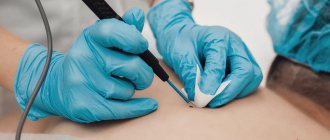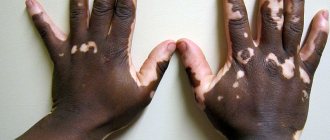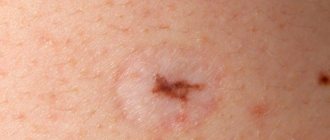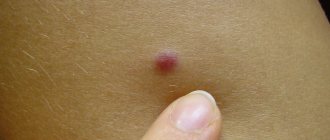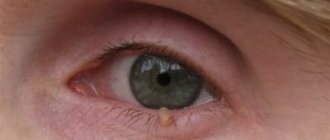Indications for removal of nevi
Most often, people with large tumors on the face or body ask to remove the growth; pigmented nodes can be very large in size, often bleed due to friction with clothing and simply cause aesthetic discomfort.
When to remove moles:
- fuzzy outline;
- frequent mechanical injuries;
- rapid growth and change in color and consistency of the mole;
- pain, itching, discharge of ichor in the area of the growth;
- uneven coloring;
- the formation of an inflamed corolla around the mole;
- the appearance of nodules and black spots on the surface;
- formation of cracks, ulcers and pronounced thickening of moles;
- localization of nevi on the eyelids, in the scalp, on the soles of the feet.
Before removal, it is recommended to consult a dermatologist or oncologist.
The doctor will perform a dermatoscopy, assess the condition of the tissue, and after excision, send the material for histological examination to exclude the possibility of developing melanoma.
Why do warts occur?
All warts (with the exception of senile warts) are provoked by the human papillomavirus. HPV penetrates the tissues of the skin or mucous membranes from the external environment, infects epidermal cells, causing their accelerated division. The result is a growth on the surface of the skin.
This process is possible only in people with weakened immune systems; in other cases, the body’s protective barriers do an excellent job of suppressing HPV activity, and warts do not form. It is important to remember that if the virus has entered the tissue, any provoking factor that weakens the immune system can lead to the growth of formations.
Warts appear due to:
- injury to the dermis (even in the form of small scratches);
- hormonal changes;
- constant stress;
- hyperhidrosis (excessive sweating).
You can become infected from a sick person through personal contact.
Removal methods
There are several ways to get rid of nevi on the face and body. These are radio wave surgery, cryodestruction, electrocoagulation and laser therapy. Classical cutting out of the growth with a scalpel is now performed in rare cases, only when there is a suspicion of malignant degeneration and if the size of the mole is very large.
Electrocoagulation
What is the best method for removing moles? One of the effective methods of treatment is the exposure of pathological tissue to high-frequency currents. The procedure lasts no more than 20 minutes, is practically painless, and sensitive patients are given local anesthesia. Since during the operation all small vessels of the skin are coagulated, bleeding does not occur.
Laser therapy in the removal of skin tumors
The targeted effect of a laser beam allows you to target the pathological area without affecting healthy tissue. The doctor independently controls the depth of penetration of the laser beam and the radiation power. This approach makes the procedure low-traumatic and virtually painless.
How does the procedure work?
Typically, the entire complex of manipulations aimed at removing a nevus takes about 15 minutes. Immediately before removal, the patient is given local anesthesia, after which the specialist begins work. One or more skin tumors can be removed in one procedure; the result depends on the size and area of localization of the nevus. The versatility of the laser lies in the fact that there are no hard-to-reach places for it; it is used both on the skin and mucous membranes. Using a laser beam, moles, papillomas, warts, fibromas, hemangiomas, and atheromas of any size and shape are removed.
Pros and cons of laser therapy
pros
- speed of the procedure;
- short period of skin recovery;
- all manipulations are performed on an outpatient basis;
- bloodlessness, since the laser seals small vessels and capillaries during exposure;
- safety and low probability of infection, since there is no direct contact of the laser beam with the patient’s blood;
- the risk of tumor recurrence is negligible.
Minuses
- relatively high cost of the procedure;
- inability to conduct a histological examination of the biomaterial.
Skin care after removal
After burning off the nevus, a crust remains on the skin, which disappears on its own after about a week. It is not recommended to tear it off, since the exposed tissue can become infected and cause an inflammatory process. During the week after the procedure, experts do not recommend applying cosmetics to the wound or visiting a solarium, swimming pool or sauna. In summer, it is necessary to use a cream with a UV filter.
You may be interested in: After laser treatment
Contraindications to laser removal
Despite its effectiveness and safety, the procedure is prohibited if:
- the patient has been diagnosed with epilepsy, diabetes mellitus or cancer, regardless of type and stage;
- pathologies of blood vessels or heart are present;
- the woman is pregnant or breastfeeding.
Folk remedies
What is the best way to remove moles? Is it possible to use folk recipes to cauterize the growths? You cannot carry out any impact on nevi without first consulting an oncologist, since malignant moles can begin to progress faster and cause severe complications.
Small moles on the body can be removed using celandine juice. Apply 1-2 drops of herbal remedy to the surface of the growth 2-3 times a day. This drug has a cauterizing and antibacterial effect, the tissues gradually die and are destroyed. It is important to prevent the formation of a deep burn so that a scar does not remain later.
Moles and plant acids will be removed; the skin should be lubricated with lemon, tomato, garlic juice, and 9% table vinegar. An ointment made from egg yolks and pumpkin oil and a solution of hydrogen peroxide help well. A mixture of chalk and hemp oil painlessly removes small moles, warts and papillomas.
Rehabilitation
Since radio wave removal of benign formations takes place without direct contact of the electrode with the skin, there are practically no possible complications after such an operation, and the rehabilitation period will go smoothly, and most importantly, will not drag on for a long time.
After a specialist carries out this procedure, it is imperative to follow the following recommendations:
- Do not expose your skin to strong UV radiation unless you have previously applied a protective cream.
- Do not visit the bathhouse, sauna or swimming pool for several days after the procedure.
- Treat the skin surface with an antiseptic solution three times for a few more days, as a crust forms.
In conclusion, it is worth noting that the removal of such benign neoplasms as moles is not a complex and dangerous operation, so you should not be afraid to do it, and if any signs of malignancy appear, you should immediately contact a doctor who will prescribe and remove suspicious nevi.
What are the dangers of removing moles?
Self-cauterization of nevi at home can lead to complications:
- bleeding;
- scar formation;
- infection, tissue suppuration;
- malignancy.
Only a doctor can determine the likelihood of developing a cancerous tumor and choose the right method for removing skin tumors. If melanoma is suspected, laboratory tests are ordered, and the excised tissue is checked for the presence of cancer cells.
The best way to remove moles with laser or electrocoagulation is determined by the oncologist after examining the patient. The treatment method is selected individually for each patient, taking into account the size, consistency and location of the growth.
Pros and cons of radio wave removal of papillomas
Papillomas grow in colonies
The appearance of papillomas is a symptom of the human papillomavirus, which is one of the most common infections.
During therapy, it is recommended to remove such growths to stop the spread of the virus. There are many methods of removal, among which radio wave destruction is especially prominent.
This is a modern method that is preferred today in many operations.
Contraindications
Despite the safety and painlessness of the procedure, it also has its contraindications. Among them:
- the presence of malignant tumors;
- period of pregnancy or lactation;
- exacerbation of chronic diseases;
- acute form of infectious diseases (herpes, influenza, etc.);
- heart pathologies;
- diabetes.
In addition, the use of a device with radio waves requires the absence of any devices powered by electricity. Therefore, radio wave removal is not suitable for patients with pacemakers. Patients with other devices, such as hearing aids, will need to remove them before the session.
Stages of the procedure
The removal of the growth itself is quick, but before this the patient needs to prepare for the procedure. Thus, the process of removing a tumor takes several stages.
Preparatory stage
Any operation to destroy existing growths should be carried out under the supervision of a dermatologist. At this stage, the sequence of actions will be as follows:
- Initial examination. During the examination, the type of tumor is determined, a medical history is taken, and a method for removing the growth is selected. The presence of contraindications and pathologies in the patient is determined. If any, additional treatment is prescribed before removal.
- Taking tests. In addition to general tests prescribed for any intervention, papillomas must be studied using histology. This is necessary in case the tumor turns out to be malignant. Such growths cannot be removed using the usual procedure.
- Setting a date for surgery. If the patient has no contraindications to the procedure, the doctor appoints a day for the procedure.
In this case, the patient does not need to perform any special preparation before the operation.
Carrying out the operation
The entire procedure is carried out in the clinic and does not take much time. The duration of removal depends on the size and number of growths. In general, the operation can take from 5 to 30 minutes . The process itself looks like this:
- Anesthesia. Any intervention occurs when the integrity of the tissue is violated, which implies the presence of pain in the area of intervention. To prevent them, the doctor usually suggests local anesthesia. Painkillers can be in the form of injections, for example, Novocaine, or creams and sprays. The choice of a specific agent depends on the sensitivity of the patient.
- Removing the build-up. After the anesthesia takes effect, the doctor begins the procedure for destroying the growth. A radio wave knife heated by electric current acts on the neoplasm. Thanks to this, the growth on the skin is removed very quickly and immediately to the base. At the same time, cauterization of the vessels occurs, resulting in a hemostatic effect.
- Treatment of the wound. After the operation is completed, the doctor will treat the affected area with antiseptic agents, for example, potassium permanganate, and tell you how to treat the wound yourself.
An important stage in all therapy is the prescription of drug treatment necessary to prevent relapses. The patient should also be consulted on this issue by the attending physician.
You can see how the removal process occurs in our video:
Consequences
Removal of any tumors using Surgitron is a safe, non-invasive intervention. During and after the operation, the patient practically does not feel any discomfort.
Radio wave destruction is not characterized by complications such as burns, swelling or inflammation. The recovery period passes quite quickly, and the frequency of relapses with proper therapy is minimal.
Before removalAfter removal
Care
The radio wave removal method is considered a light intervention, so a second visit to the doctor is not required after the procedure. There are no stitches after the operation, and there is no need for complex daily treatment. Therefore, the patient will be able to perform all care procedures independently.
After radio wave destruction, a scab appears at the site of removal.
It performs a protective function, protecting damaged tissues from the penetration of microbes and aggressive environmental influences.
This area must be treated several times a day with antiseptic and regenerating drugs. This will make the entire healing process faster.
Usually healing ends after 5-7 days , after which the crust disappears. You should not touch it or try to separate it yourself.
After this, the scab will separate, and underneath there will be clean skin. It turns out to be a different shade and differs from neighboring skin. This is considered normal and does not affect the patient’s health in any way. A small scar usually remains at the site of removal of the growth, which disappears 1-3 months after the procedure.
Source: https://papillomus.ru/udaleniye/radiovolnovoe-udalenie-papillom/
What is Surgitron and its use for skin growths
Surgitron is a special device widely used in radio wave therapy of tumors. The equipment is called a radio knife.
The use of radioknife has advantages over other treatment methods:
- Eliminates benign growths on any part of the body.
- The radio knife does not injure the skin.
- During the procedure, the patient does not feel pain, burning, or itching.
- After removal of tumors there is no bleeding.
- The patient does not need to go to the hospital. The procedure is carried out in a regular outpatient clinic.
- Recovery after radio wave treatment takes a minimal amount of time.
- After removal of the formations, the resulting material is sent for histology. It is possible to find out the nature of the growth (malignant or benign).
- The radioknife acts exclusively on the pathological area. Healthy tissues are not injured.
- The procedure does not leave visible skin defects: scars, cicatrices.
- No special preparation is required for the procedure.
- Removing warts with surgitron has virtually no contraindications.
- After the procedure there are no inflammatory phenomena on the skin.
- Prevents the development, progression of pathology, its complications.
- The procedure does not take more than 20 minutes.
Radio wave therapy was first used to remove small skin tags. The procedure is widely used to treat gynecological and dermatological problems. The radio knife removes cervical dysplasia and condylomas on the genitals.
Contraindications
Despite the safety and painlessness of the procedure, it also has its contraindications. Among them:
- the presence of malignant tumors;
- period of pregnancy or lactation;
- exacerbation of chronic diseases;
- acute form of infectious diseases (herpes, influenza, etc.);
- heart pathologies;
- diabetes.
In addition, the use of a device with radio waves requires the absence of any devices powered by electricity. Therefore, radio wave removal is not suitable for patients with pacemakers. Patients with other devices, such as hearing aids, will need to remove them before the session.
What to choose
Before choosing a method, it is best to consult with a cosmetologist involved in the removal of tumors. The doctor will be able to choose the right procedure, depending on the patient’s age, the individual characteristics of his body, the type of tumor and contraindications.
Contraindications are important. Both methods are similar, but the laser has more contraindications - therefore, when talking with your doctor, you must inform him about all chronic diseases. Before the operation, you will need to undergo some tests and examinations to exclude pathologies that are contraindications.
Surgitron is more suitable for removing papillomas and condylomas - in some cases, these neoplasms are a manifestation of skin cancer, and after removal, they can be sent for examination. The same method is recommended for eliminating voluminous moles.
For the treatment of cervical erosion, surgitron is more suitable, since it has a shorter period of healing of the epithelium and after it no scars form on the walls of the organ.
It must be remembered that the operation must be performed by an experienced cosmetologist, so the choice of a specialist and clinic must be approached carefully and responsibly. The clinic must have all the necessary certificates and licenses.
Which is better: surgitron or laser
Mortality from degenerated moles and papillomas is high. Melanoma, which is formed from damaged nevi, gives many metastases to internal organs.
Papillomas are caused by HPV. The latter is a dangerous virus that slowly destroys epithelial cells in the human body. Malignancy of the tissue occurs. There are more than 100 types of papillomaviruses; only some strains cause serious pathologies.
Thanks to the development of medicine, the mortality rate from both diseases has been reduced. Laser and radio wave therapy treats warts, moles, and condylomas quickly and effectively. Both methods have similar properties: they remove formations painlessly, do not leave scars, and are carried out on an outpatient basis in a short period of time.
Which method of dealing with skin growths to choose is determined by the attending physician together with the patient. In addition to indications and contraindications, the patient’s financial capabilities are taken into account.
Laser surgery differs from radio wave procedure technology and mechanism of action. The laser burns out the mole and promotes thrombosis of small vessels that supply blood to the benign tumor. This action prevents the spread of metastases and minimizes blood loss. After removal, a crust remains on the pathological site, protecting the wound from infection. After a week it disappears. There are no traces left of the nevus.
Radio wave surgery destroys tumors by applying thermal energy to them. Methods indicated for treatment:
- Pigmented, vascular neoplasms.
- Fibromas and old areas of keratoses.
- The methods are used to treat cancer in situ to prevent the spread of atypical cells through the bloodstream and the formation of secondary lesions.
- Laser and radio wave surgery is used for gynecological diseases that easily turn into cancer. Among them are dysplasia and leukoplakia of the cervix.
- The procedures are performed in patients with benign diseases of the urinary canal (fibromas, papillomas).
A common disadvantage of the methods is their high cost. There is a high risk of malignancy of moles, their serious consequences put health above money. Removing moles with surgitron or a popular laser saves the patient’s life. Do not skimp on your own health, choose only high-quality treatments.
Differences
These methods also have differences:
- Surgitron, like a scalpel, excises the layers of skin along with the neoplasm, and the laser cauterizes the layers of the epidermis layer by layer.
- The exposure time of the radio knife is 5-20 minutes ; the laser acts more quickly - it takes no more than 2 minutes .
- Surgitron eliminates the tumor along with the area of the epidermis, and the laser acts specifically on the tumor without affecting neighboring areas of the skin.
- If the defect is eliminated using surgitron, then the removed tissue can be sent to the laboratory for histological analysis to find out whether the formation was malignant or benign. During laser exposure, tissues are burned, and it is impossible to send them for further research.
- The cost of the methods also varies - the price of the laser method starts from 200 rubles , and removal using surgitron starts from 1000 rubles .
Consequences
Removal of any tumors using Surgitron is a safe, non-invasive intervention. During and after the operation, the patient practically does not feel any discomfort.
Radio wave destruction is not characterized by complications such as burns, swelling or inflammation. The recovery period passes quite quickly, and the frequency of relapses with proper therapy is minimal.
Before removal
After removal
be careful
The presence of papillomas, warts, condylomas, moles and spines on the body is the first sign of malignant melanoma!
We hasten to warn you that most medications “treat” warts, papillomas, moles, etc. - this is a complete deception of marketers who make hundreds of percentage points on drugs whose effectiveness is zero. They do not cure the disease, but only mask the symptoms.
The pharmacy mafia makes huge money by deceiving sick people.
But what to do? How to treat if there is deception everywhere? Doctor of Medical Sciences Anatoly Makhson conducted his own investigation and found a way out of this situation. In this article, the Doctor also told how to 100% protect yourself from melanoma, for only 149 rubles! Read the article in the official source following the link.
Radio wave excision is the most modern method of removing benign skin lesions. It is suitable for eliminating moles, papillomas, warts and condylomas on the facial skin and mucous membranes. In gynecology, high-frequency radio waves are also used to treat cervical erosion.
The radio wave method is similar to conventional excision, but instead of a surgical knife, high-frequency waves are used. They are concentrated on the nevus, making microincisions in the overgrown tissues of the epidermis, and remove them layer by layer. Thanks to the thermal effects of radio waves, the blood instantly coagulates, which avoids bleeding.
After the procedure is completed, the removed tissue is sent for histological analysis to ensure that the lesion was benign.
- During the procedure, healthy tissue is not damaged;
- removal is painless;
- zero risk of bleeding or infection;
- no scars remain at the site of the removed formations;
- low risk of relapse when removing papillomas;
- short rehabilitation period;
- low risk of complications.
- the procedure does not take much time.
The radio wave method has only two disadvantages: high cost (from 700 to 3000 rubles) and the impossibility of application on large tumors.
Removal of skin lesions using radio waves has the following contraindications:
- cancerous degeneration of mole tissue;
- exacerbation of chronic pathologies;
- presence of infectious diseases;
- the procedure is contraindicated for patients with installed cardiac sensors;
- chronic skin diseases;
- herpetic rashes;
- menstruation, as well as pregnancy and lactation
- glaucoma;
- epilepsy;
- diabetes.
Patients often wonder what is better, radio wave or laser mole removal. Burning out formations with a laser is the second most effective method after radio wave, but it has a number of disadvantages. Laser removal is more expensive, the procedure itself is often painful, and charred tissue cannot be used for histological analysis.
Surgitron
Surgitron (radio knife) is a cosmetic device that emits short radio waves . Under their influence, the skin tumor is excised and completely removed along with the area of the epidermis on which it is located. The radio wave acts like a surgical scalpel, but does not cause bleeding, since blood tends to coagulate at high temperatures.
Using a radio knife, you can remove voluminous moles, warts, papillomas and condylomas, and cure cervical erosion. This method has the following advantages:
- The operation takes place under local anesthesia.
- The duration of the procedure is 5-20 minutes , depending on the size of the tumor.
- After the operation, no stitches are required, so no scars are formed.
- The regeneration time of the epidermis is 7-15 days .
- The removed tissue can be sent for laboratory testing.
- You can remove the tumor the first time.
After surgery, a hard brown crust forms at the site of the defect, which cannot be torn off from the skin and must be disinfected daily. In a few days the crust will disappear.
- Malignant tumors.
- Implanted pacemaker.
- Pregnancy and lactation period.
- Psoriasis, dermatitis, eczema in the neoplasm area.
- Increased body temperature.
- ARVI, acute respiratory infections, influenza.
- Malaise.
- Period of solar activity (spring-summer).


